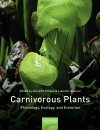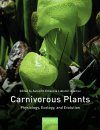About this book
Carnivorous plants have fascinated botanists, evolutionary biologists, ecologists, physiologists, developmental biologists, anatomists, horticulturalists, and the general public for centuries. Charles Darwin was the first scientist to demonstrate experimentally that some plants could actually attract, kill, digest, and absorb nutrients from insect prey; his book Insectivorous Plants (1875) remains a widely-cited classic. Since then, many movies and plays, short stories, novels, coffee-table picture books, and popular books on the cultivation of carnivorous plants have been produced. However, all of these widely read products depend on accurate scientific information, and most of them have repeated and recycled data from just three comprehensive, but now long out of date, scientific monographs. The field has evolved and changed dramatically in the nearly 30 years since the last of these books was published, and thousands of scientific papers on carnivorous plants have appeared in the academic journal literature. In response, Ellison and Adamec have assembled the world's leading experts to provide a truly modern synthesis. They examine every aspect of physiology, biochemistry, genomics, ecology, and evolution of these remarkable plants, culminating in a description of the serious threats they now face from over-collection, poaching, habitat loss, and climatic change which directly threaten their habitats and continued persistence in them.
Contents
Part I: Overview
1: Introduction, Aaron M. Ellison and Lubomír Adamec
2: Biogeography and habitats of carnivorous plants, J. Stephen Brewer and Jan Schlauer
3: Evolution of carnivory in angiosperms, Andreas Fleischmann, Jan Schlauer, Stephen A. Smith, and Thomas J. Givnish
Part II: Systematics and evolution of carnivorous plants
4: Systematics and evolution of Droseraceae, Andreas Fleischmann, Adam T. Cross, Robert Gibson, Paulo M. Gonella, and Kingsley W. Dixon
5: Systematics and evolution of Nepenthes, Charles Clarke, Jan Schlauer, Jonathan Moran, and Alastair Robinson
6: Systematics and evolution of Lentibulariaceae: I. Pinguicula, Andreas Fleischmann and Aymeric Roccia
7: Systematics and evolution of Lentibulariaceae: II. Genlisea, Andreas Fleischmann
8: Systematics and evolution of Lentibulariaceae: III. Utricularia, Richard W. Jobson, Paulo C. Baleeiro, and Cástor Guisande
9: Systematics and evolution of Sarraceniaceae, Robert F.C. Naczi
10: Systematics and evolution of small genera of carnivorous plants, Adam T. Cross, Maria Paniw, André Vito Scatigna, Nick Kalfas, Bruce Anderson, Thomas J. Givnish, and Andreas Fleischmann
11: Carnivorous plant genomes, Tanya Renner, Tianying Lan, Kimberly M. Farr, Enrique Ibarra-Laclette, Luis Herrera- Esrella, Stephan C. Schuster, Mitsuyasu Hasebe, Kenji Fukushima, and Victor A. Albert
Part III: Physiology, form, and function
12: Attraction of prey, John D. Horner, Bartosz J. Plachno, Ulrike Bauer, and Bruno Di Giusto
13: Functional anatomy of carnivorous traps, Bartosz J. Plachno and Lyudmila E. Muravnik
14: Motile traps, Simon Poppinga, Ulrike Bauer, Thomas Speck, and Alexander G. Volkov
15: Non-motile traps, Ulrike Bauer, Reinhard Jetter, and Simon Poppinga
16: Biochemistry of prey digestion and nutrient absorption, Ildikó Matušiková, Andrej Pavlovic, and Tanya Renner
17: Mineral nutrition of terrestrial carnivorous plants, Lubomír Adamec and Andrej Pavlovic
18: Why are plants carnivorous? Cost/benefit analysis, whole-plant growth, and the context- specific advantages of botanical carnivory, Thomas J. Givnish, K. William Sparks, Steven J. Hunter, and Andrej Pavlovic
19: Ecophysiology of aquatic carnivorous plants, Lubomír Adamec
20: Biotechnology with carnivorous plants, Laurent Legendre and Douglas W. Darnowski
Part IV: Ecology
21: Prey selection and specialization by carnivorous plants, Douglas W. Darnowski, Ulrike Bauer, Marcos Méndez, John D. Horner, and Bartosz J. Plachno
22: Reproductive biology and prey-pollinator conflicts, Adam T. Cross, Arthur R. Davis, Andreas Fleischmann, John D. Horner, Andreas Jürgens, David J. Merritt, Gillian L. Murza, and Shane R. Turner
23: Commensals of Nepenthes pitchers, Leonora S. Bittleston
24: Pitcher-plant communities as model systems for addressing fundamental questions in ecology and evolution, Thomas E. Miller, William E. Bradshaw, and Christina M. Holzapfel
25: The Utricularia-associated microbiome: composition, function, and ecology, Dagmara Sirová, Jirí Bárta, Jakub Borovec, and Jaroslav Vrba
26: Nutritional mutualisms of Nepenthes and Roridula, Jonathan A. Moran, Bruce Anderson, Lijin Chin, Melinda Greenwood, and Charles Clarke
Part V: The future of carnivorous plants
27: Conservation of carnivorous plants, Charles Clarke, Adam Ross, and Barry Rice
28: Estimating the exposure of carnivorous plants to rapid climatic change, Matthew C. Fitzpatrick and Aaron M. Ellison
29: The future of research with carnivorous plants, Aaron M. Ellison and Lubomír Adamec
Customer Reviews
Biography
Aaron M. Ellison is the Senior Research Fellow in Ecology at Harvard University, and a semi-professional photographer and writer. He studies the disintegration and reassembly of ecosystems following natural and anthropogenic disturbances; thinks about the relationship between the Dao and the intermediate disturbance hypothesis and reflects on the critical and reactionary stance of Ecology relative to Modernism.
Lubomír Adamec is the Senior Research Scientist in the Section of Plant Ecology of the Institute of Botany CAS at Trebon, Czech Republic, where he has been working since 1986. Since graduating in plant physiology from the Charles University in Prague, Czechoslovakia, he has been studying the ecophysiology of aquatic and wetland plants, especially carnivorous ones: mineral nutrition, photosynthesis, growth traits, Utricularia trap ecophysiology, and biophysics. He is the curator of the world's largest collection of aquatic carnivorous plants, currently including more than 80 species or populations, which is used extensively for research and plant conservation.
Contributors:
- Lubomír Adamec, Institute of Botany, Czech Republic
- Victor A. Albert, University of Buffalo, USA
- Bruce Anderson, University of Stellenbosch, South Africa
- Paulo C. Baleeiro, University of São Paulo, Brazil
- Jirí Bárta, University of South Bohemia, Czech Republic
- Ulrike Bauer, University of Bristol, UK
- Jakub Borovec, Biology Centre of the Czech Academy of Sciences, Czech Republic
- William E. Bradshaw, University of Oregon, USA
- J. Stephen Brewer, University of Mississippi, USA
- Leonora S. Bittleston, Massachusetts Institute of Technology, USA
- Charles Clarke, Australian Tropical Herbarium, Australia
- Lijin Chin, Cranfield University, UK
- Adam T. Cross, Curtin University, Australia
- Douglas W. Darnowski, Indiana University Southeast, USA
- Arthur R. Davis, University of Saskatchewan, Canada
- Bruno Di Giusto, Ming Chuan University at Taipei, Taiwan
- Kingsley W. Dixon, Curtin University, Australia
- Aaron M. Ellison, Harvard University, USA
- Kimberly M. Farr, University at Buffalo, USA
- Matthew C. Fitzpatrick, University of Maryland, USA
- Andreas Fleischmann, Munich Herbarium, Germany
- Kenji Fukushima, University of Colorado, USA
- Robert Gibson, New South Wales Office of Environment and Heritage, Australia
- Thomas J. Givnish, University of Wisconsin-Madison, USA
- Paulo M. Gonella, University of São Paulo, Brazil
- Melinda Greenwood, Northern New South Wales, Australia
- Cástor Guisande, University of Vigo, Spain
- Mitsuyasu Hasebe, National Institute for Basic Biology, Japan
- Luis Herrera-Esrella, Langebio, Mexico
- Christina M. Holzapfel, University of Oregon, USA
- John D. Horner, Texas Christian University, USA
- Steven J. Hunter, University of Wisconsin - Madison, USA
- Enrique Ibarra-Laclette, INECOL, Mexico
- Reinhard Jetter, University of British Columbia, Canada
- Richard W. Jobson, National Herbarium of New South Wales, Australia
- Daniel M. Joel, Volcani Institute, Israel
- Andreas Jürgens, Technical University of Darmstadt, Germany
- Nick Kalfas, University of Adelaide, Australia
- Tianying Lan, University at Buffalo, USA
- Laurent Legendre, University of Lyon, France
- Ildikó Matusiková, University of Ss. Cyril and Methodius in Trnava, Slovak Republic
- Marcos Méndez, Rey Juan Carlos University, Spain
- David J. Merritt, Kings Park and Botanic Garden, Australia
- Thomas E. Miller, Florida State University, USA
- Jonathan A. Moran, Royal Roads University in Victoria, Canada
- Lyudmila E. Muravnik, Komarov Botanical Institute, Russia
- Gillian L. Murza, University of Saskatchewan, Canada
- Robert F.C. Naczi, The New York Botanical Garden, USA
- Maria Paniw, University of Cadiz, Spain
- Andrej Pavlovic, Palacký University in Olomouc, Czech Republic
- Bartosz J. Plachno, Jagiellonian University, Poland
- Simon Poppinga, University of Freiburg, Germany
- Tanya Renner, San Diego State University, USA
- Barry Rice, University of California, USA
- Alastair Robinson, Cambridge University, UK
- Aymeric Roccia, DNA Gensee, France
- André Vito Scatigna, University of Campinas, Brazil
- Jan Schlauer, The University of Tübingen, Germany
- Stephan C. Schuster, Center for Comparative Genomics and Bioinformatics, USA
- Dagmara Sirová, University of South Bohemia, Czech Republic
- Stephen A. Smith, University of Michigan, USA
- K. William Sparks, University of Wisconsin - Madison, USA
- Thomas Speck, University of Freiburg, Germany
- Shane R. Turner, University of Western Australia, Australia
- Alexander G. Volkov, Oakwood University, USA
- Jaroslav Vrba, University of South Bohemia, Czech Republic







































